The Orchard Inside the Walls by Andrew Jackson

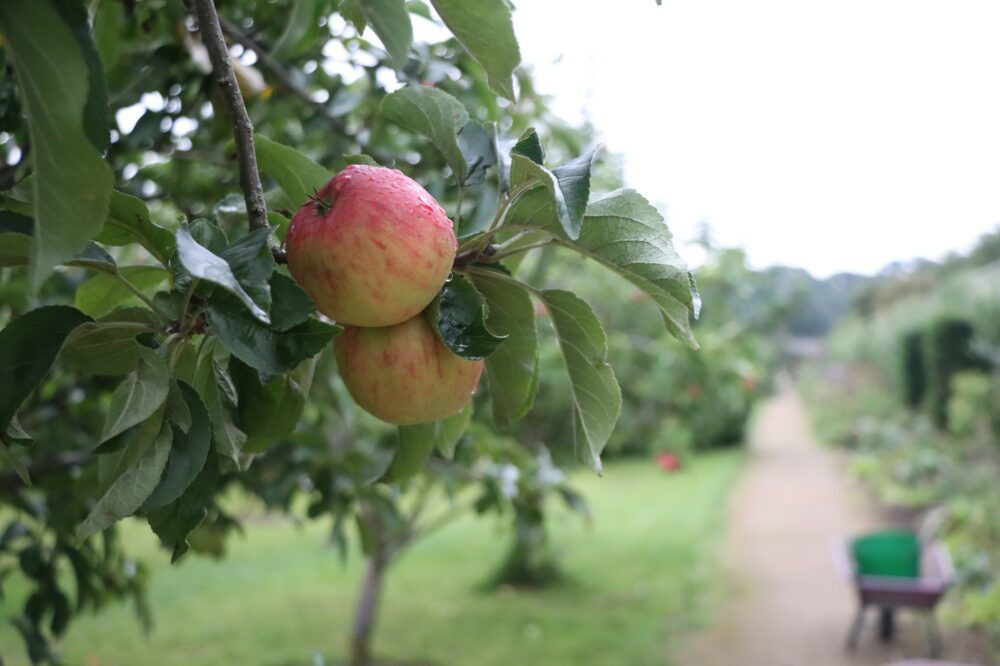
Now that we’re in the midst of autumn, we’re delighted to bring you another seasonal instalment from our resident writer, Andrew Jackson. We recommend finding a warm and cosy corner, make a cup of tea, then settle in and allow Andrew’s words to be your portal into the garden as its summer offerings begin to fade and the slow season creeps up on us.
Over to Andrew…
The Orchard Inside the Walls
The first apple I see is not the first I smell. Before my eyes adjust to the filtered sunlight of the orchard, before the brick walls make their warmth felt on my back, the air itself is apple-scented: faintly tannic, part sweetness, part fermentation. Fallen fruit are already softening in the grass, their skins loosened by the gentle bruising of gravity. This is the perfume of October, and of an old English orchard breathing in its own memory.
Helmsley’s walled garden sits beneath the broken teeth of the castle keep, where stone and lichen have shared centuries of weather. The garden walls—red brick, heat-holding, hand-made—form a second castle of sorts, a refuge for more tender things. Within them, the apple trees are not regimented soldiers but a congregation of individuals: crooked, leaning, full of gesture. Each trunk has its own handwriting. One stoops as if whispering to the ground, another lifts its limbs as though in benediction.
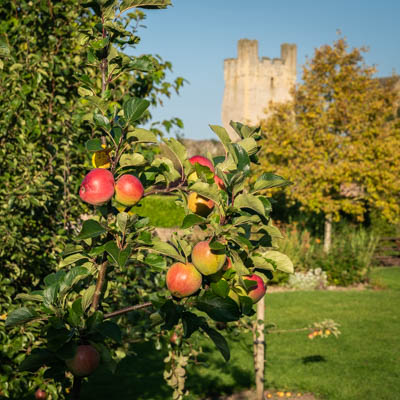
An orchard is an argument made with time. These trees have been planted and replanted through more than a century of horticultural optimism, neglect, and rediscovery. There was the era when kitchen gardens like this were engines of estate self-sufficiency, when the glasshouses and trained espaliers produced fruit for the house above. Then came dereliction, the slow-creeping wilderness that follows human retreat. The apple roots held on beneath bramble and dock. And now, in its present incarnation as a charitable garden, Helmsley’s orchard has taken on yet another life—one of care, restoration, therapy, and community.
Walking between the rows, I can see all these layers at once. The trees are as much palimpsests as plants. One branch bears fruit the size of a child’s fist, a green fading to dull gold; the next carries scarlet globes so small they could pass for crab apples. A few trees have labels wired loosely to their stems—Ribston Pippin, Lord Lambourne, Beauty of Bath—names that sound like half-remembered relatives. Many have lost their labels, and are left to speak for themselves. I like that. Apples have always existed in a state of creative miscegenation. Even a single pip can yield a new and unrepeatable variety. Perhaps the orchard’s greatest gift is its readiness to reinvent itself.

A robin hops from the low fork of one tree, flits to another, sings a few clean notes. A wasp, drunk on fermenting juice, bumbles into a windfall and circles lazily as though orbiting a minor sun. The fruit on the grass has already entered another ecology. Slugs, wasps, ants, fungal threads—they are the orchard’s night shift. The apple does not die so much as diffuse itself: sugars to soil, scent to air, seeds to chance. We call it waste; the orchard calls it continuity.
The walls of the garden are alive too. Their bricks breathe warmth into the air, keeping frost from the lowest boughs. Mosses have colonised the mortar in intricate maps of green. Ivy pushes thin fingers through cracks, testing the architecture. On the north wall, where the sun rarely falls, lichen forms grey continents. The wall is less a boundary than an ecosystem, a vertical landscape holding the orchard in gentle custody.
There’s an intimacy to walled gardens that makes them feel like interiors, as though one has stepped inside the mind of cultivation itself. You can almost hear the pulse of sap, the slow drag of roots through loam. And yet the boundaries do not keep the wild out—they modulate it. Over the top of the wall, I can see the sharp edge of the North York Moors, the heather now bronzed by autumn. Wild and tended meet at the mortar line. I find that thought reassuring: no real division between human order and natural exuberance, only a negotiation.

In one corner of the orchard stands a tree that looks to have half collapsed. Its trunk is split, the inner heartwood exposed, a soft amber where the rot has taken hold. And yet the outer bark remains alive; a green flush of leaves crowns one remaining arm. It’s tempting to see defiance in this—life insisting, stubbornly, on carrying on. But what strikes me more is the seamlessness of decay and growth. Fungi stipple the fallen half of the trunk, beetles move through the seams. The tree has simply changed vocation, from fruit-bearer to host.
It is hard not to think of how many orchards we’ve lost. In the last half-century, England’s traditional orchards have dwindled to a fraction of their former extent. Fields that once carried scatterings of fruit trees—those lovely loose arrangements of meadow, livestock, and shade—have been consolidated into pure arable. We’ve traded complexity for efficiency. But an orchard is more than an agricultural system. It’s a social organism, a common ground between species. Thrushes feed on its berries; moths breed on its bark; humans find shelter and symbol among its branches. To lose an orchard is to lose a language.
Here, within these walls, that language still murmurs. I stop beside a gnarled specimen whose fruit are small, russeted, their skins rough as sandpaper. I pick one up from the grass, wipe it on my sleeve, bite. The taste is dry and aromatic, the sweetness restrained. The juice carries the mineral tang of the soil, as if it remembers the stone beneath. Eating an apple like this is a kind of reading. Each flavour is a line of text: sunlight, chlorophyll, rain. The fruit is an autobiography of place.
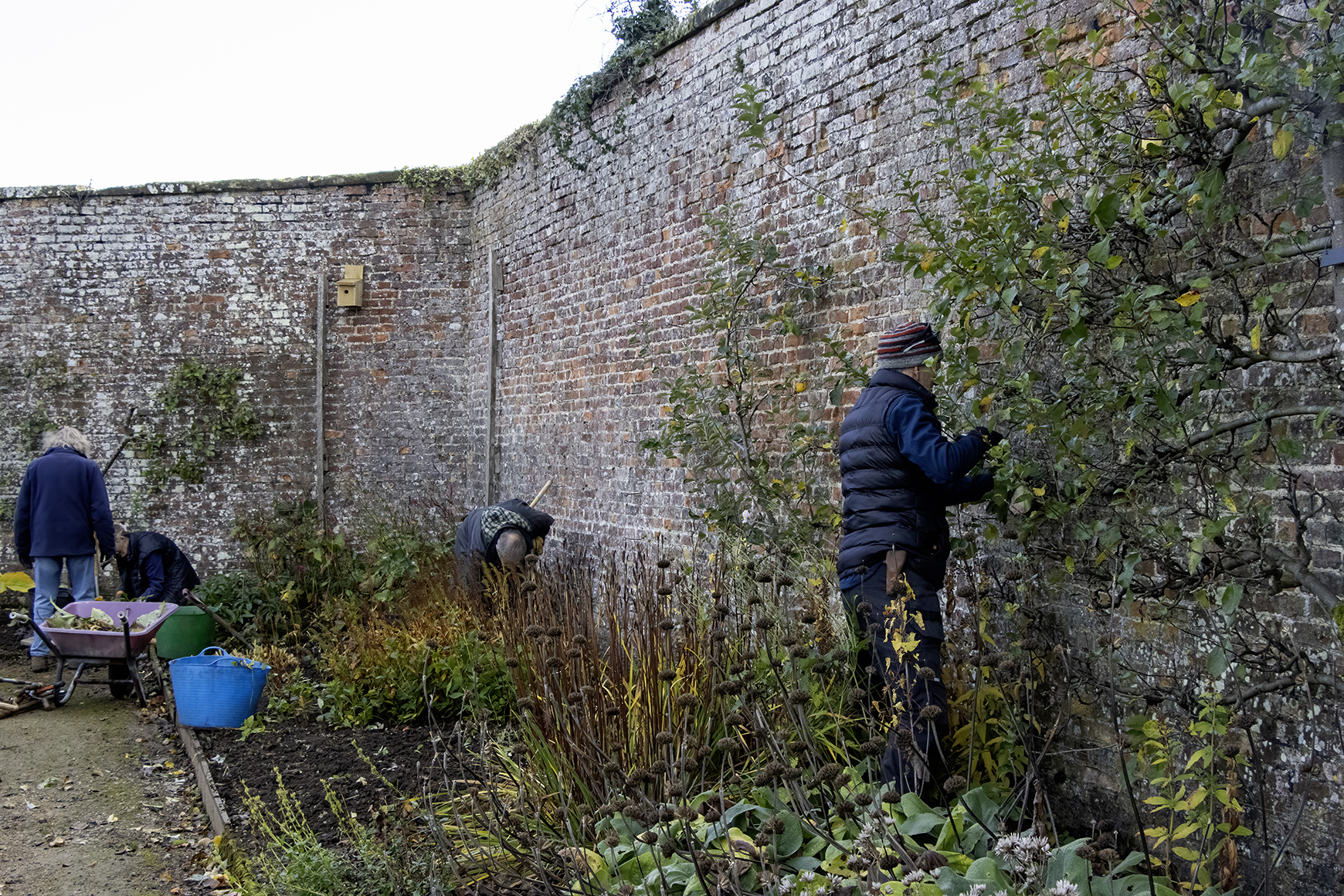
I find myself wondering about the hands that grafted these trees. Someone, a century ago perhaps, made those precise incisions, bound the rootstock and scion together with raffia, and hoped. A gesture of faith. The young graft must have looked fragile then, as thin and vulnerable as a matchstick. Now its scar has thickened into the living architecture of a trunk. We often speak of grafting as a metaphor for human creativity, but perhaps it is the other way around: our creativity imitates the tree’s capacity for union and renewal.
By noon the orchard hums. Bees still work the late flowers of nearby herbs; wasps crowd the split fruit; a blackbird chinks from the wall. The sun, caught by the bricks, feels almost Mediterranean. I sit on a low bench and watch light shift across the grass. Each apple throws its own small shadow, each leaf its own semaphore. In this moment of stillness, the garden seems less a place of cultivation than of listening. You begin to hear how the trees converse—through the exchange of air and scent, through the dull thud of an apple falling, through the invisible underground conversations of roots and fungi. The orchard is an orchestra of slow intelligences.
Some of the trees here were planted during the garden’s restoration in the 1990s, when the site was reclaimed from dereliction. I remember visiting then, the walls clothed in nettle and bindweed, the glasshouses roofless, the orchard half-lost. What struck me even in that ruin was the persistence of life: apple suckers pushing through bramble, ghostly white blossoms on branches that hadn’t felt a pruning saw in decades. Restoration, in such places, is less about imposing order than about recognising what has endured.
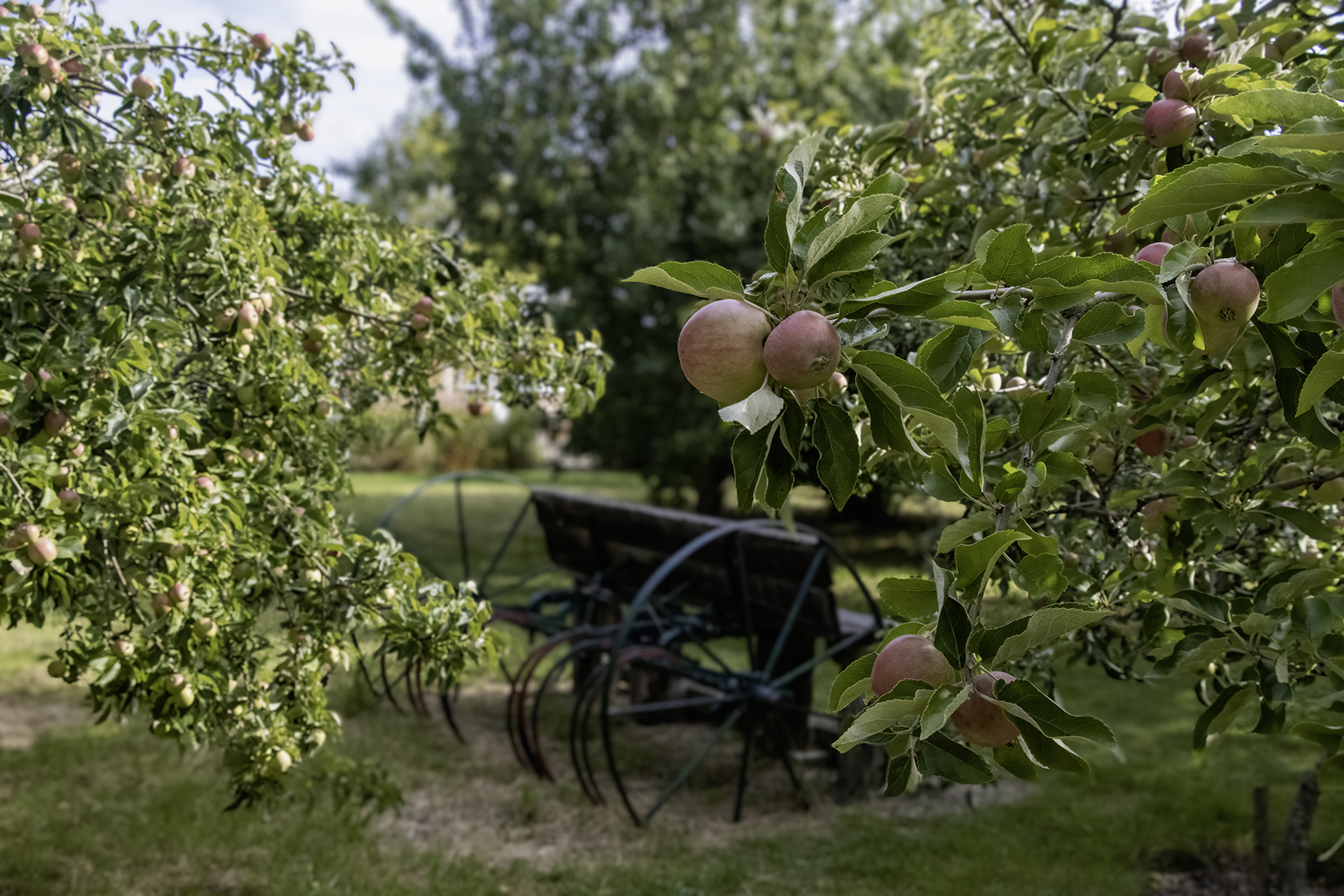
And that’s what has always drawn me to orchards—their peculiar balance of artifice and wildness. They are human in their origins, but vegetal in their temperament. You plant an orchard to feed the future, knowing you may never taste the full crop. Yet once the trees mature, they become largely self-regulating. Pruning, yes, a little thinning perhaps—but mostly patience. The orchard grows according to its own negotiations with light and wind. It is a society of individuals cooperating loosely, a parliament of trees.
Here at Helmsley, loss feels temporarily held at bay. The orchard is both memorial and renewal. The volunteers who tend it—pruning, mulching, gathering, sharing—are part of a longer continuity that stretches back to the earliest grafts. The trees, in their slow way, answer. Their blossoms return each spring, their fruit sets, their branches age. The cycle repeats, not exactly, but recognisably.
As afternoon deepens, a cool shadow moves in from the wall. The air thickens with the smell of ripe fruit, overlaid with the faint musk of leaf mould. Apples fall occasionally, softly, as if the trees are exhaling. I think of how the orchard feeds not only stomachs but imaginations. In our folklore, apples carry every kind of meaning—knowledge, temptation, health, immortality. Yet the real miracle is simpler: the tree’s ability to conjure sweetness from air and sunlight. To turn the impalpable into the edible.
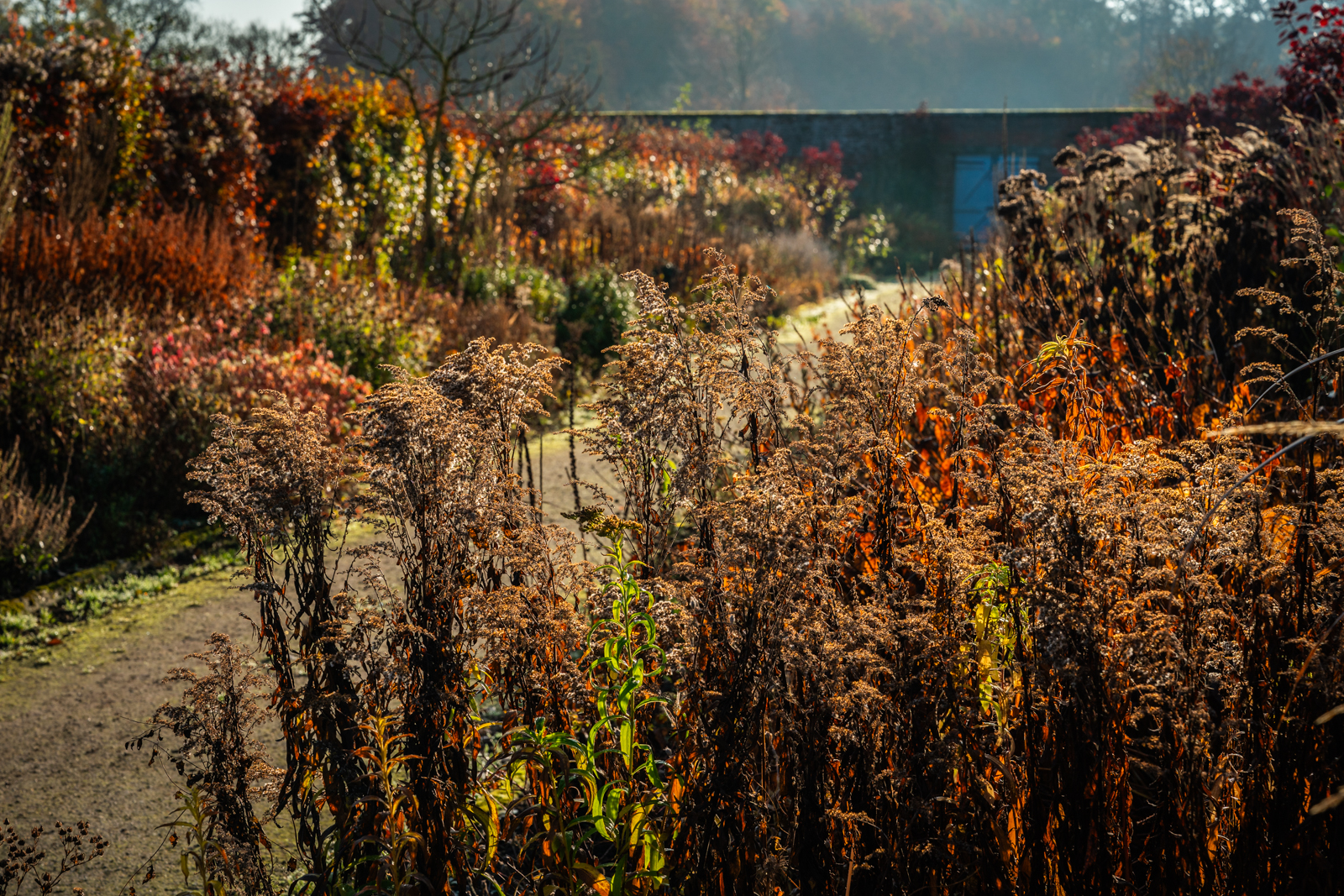
I walk once more along the central path, touching the bark of each tree as I pass. Some are smooth, some fissured, some damp with moss. I find myself thinking less about the fruit and more about the quiet, enduring presence of these beings who outlive our projects and our impatience. The orchard is patient in a way we rarely are. It measures time in rings and seasons, not deadlines.
A gust of wind shakes the branches, and for a moment the orchard is filled with motion—leaves, fruit, light all moving together. Then the wind drops, and silence returns, a silence that is never complete but layered with insect buzz, with distant rooks, with the steady ticking of ripening. The world has slowed to the orchard’s tempo.
At the far wall, I pause and look back. From here the garden spreads like a patchwork of memory—beds of vegetables, flowers, herbs, all framed by the disciplined geometry of the bricks. And within that geometry, the orchard persists, its trees both formal and free. They remind me that cultivation is not control but conversation. That every act of tending is also an act of listening.
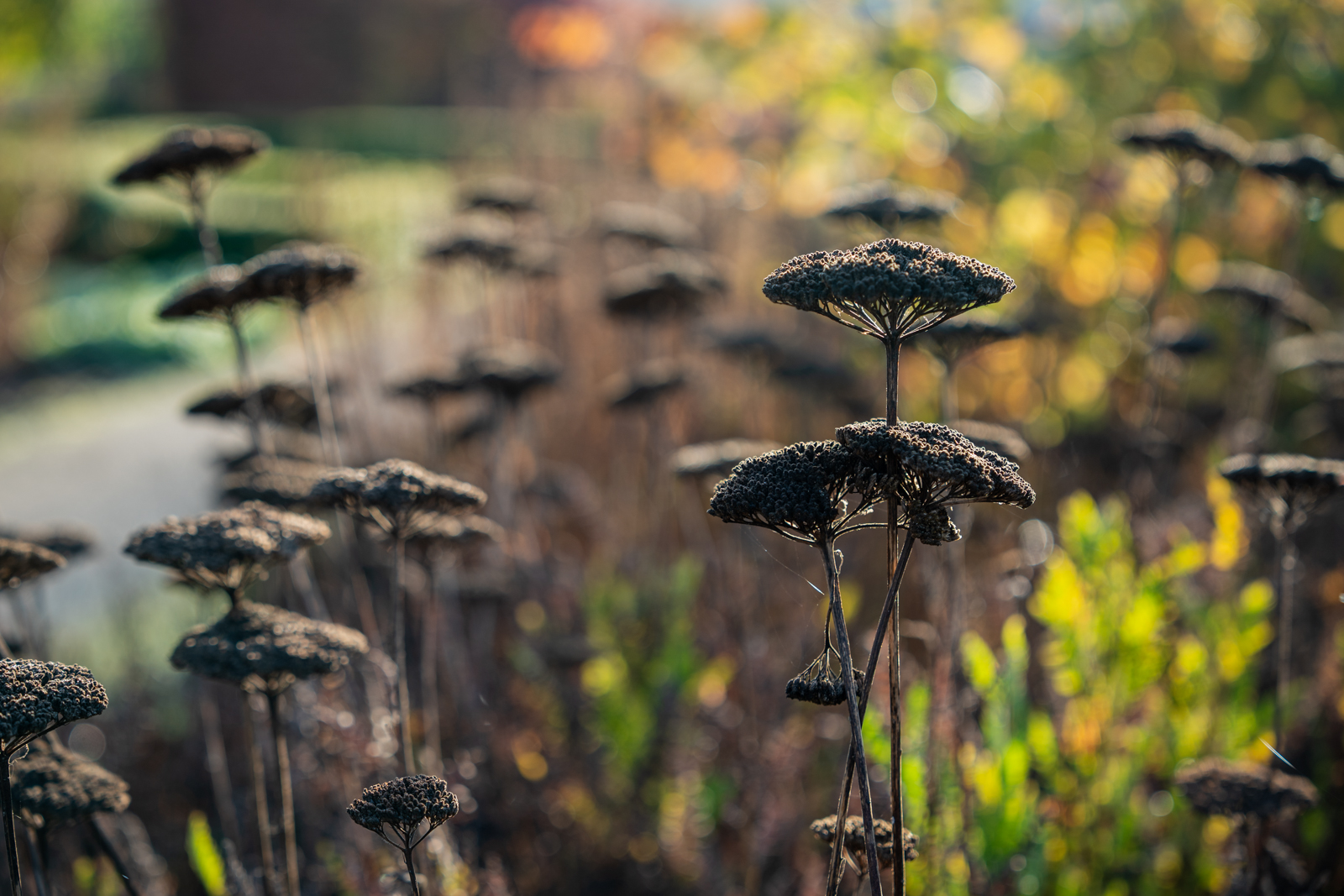
The light is lowering now, slipping between trunks, gilding the undersides of leaves. I stoop to pick one last apple, a small red sphere with faint vertical striping. I don’t know its name, and that feels right. I bite; the flesh is cool, sharp, startlingly alive. The taste carries the whole season within it—the cold of winter, the bees of spring, the rains of summer, the warmth of these enclosing walls.
I finish the apple, drop the core onto the grass, and leave it there. Tomorrow, something will find it. A wasp, a mouse, a blackbird. The seeds will fall into the soil, and maybe one will take root, and maybe not. The orchard will decide.
Outside the gate, the air feels thinner, the sounds of the town reassert themselves. But behind the wall, the orchard goes on with its quiet work—ripening, rotting, resting, beginning again.
And as I walk away, I can almost hear it breathing.
Andrew Jackson
Andrew is a new build gardener and the visionary founder of the New Build Manifesto, a campaign championing better access to and higher quality new build spaces. As an award-winning garden designer and writer who was featured on BBC Gardeners’ World in June, 2025, Andrew embodies the creativity and passion that comes from time spent outdoors, in nature .
Follow Andrew’s journey via the links below:
Scribehound Gardening
@thenewbuildmanifesto
Photo credits – Colin Dilcock, Stephen Barstow, Andrew Jackson (pictured below)
 Filed under: Blog
Filed under: Blog 


